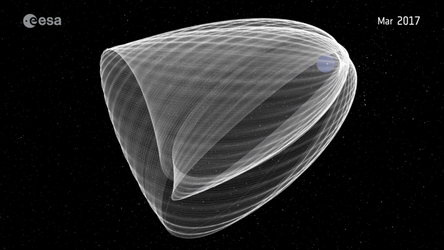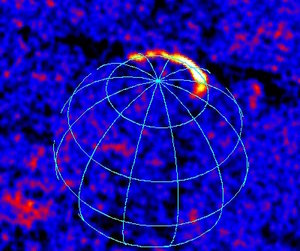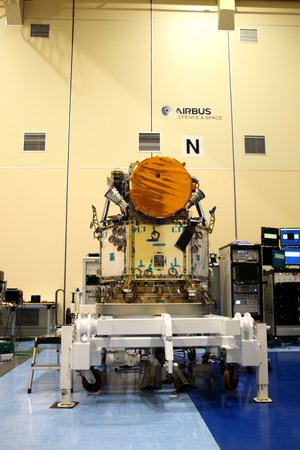Accept all cookies Accept only essential cookies See our Cookie Notice

About ESA
The European Space Agency (ESA) is Europe’s gateway to space. Its mission is to shape the development of Europe’s space capability and ensure that investment in space continues to deliver benefits to the citizens of Europe and the world.
Highlights
ESA - United space in Europe
This is ESA ESA facts Member States & Cooperating States Funding Director General Top management For Member State Delegations European vision European Space Policy ESA & EU Responsibility & Sustainability Annual Report Calendar of meetings Corporate newsEstablishments & sites
ESA Headquarters ESA ESTEC ESA ESOC ESA ESRIN ESA EAC ESA ESAC Europe's Spaceport ESA ESEC ESA ECSAT Brussels Office Washington OfficeWorking with ESA
Business with ESA ESA Commercialisation Gateway Law at ESA Careers Cyber resilience at ESA IT at ESA Newsroom Partnerships Merchandising Licence Education Open Space Innovation Platform Integrity and Reporting Administrative Tribunal Health and SafetyMore about ESA
History ESA Historical Archives Exhibitions Publications Art & Culture ESA Merchandise Kids Diversity ESA Brand Centre ESA ChampionsLatest
Space in Member States
Find out more about space activities in our 22 Member States, and understand how ESA works together with their national agencies, institutions and organisations.
Science & Exploration
Exploring our Solar System and unlocking the secrets of the Universe
Go to topicAstronauts
Missions
Juice Euclid Webb Solar Orbiter BepiColombo Gaia ExoMars Cheops Exoplanet missions More missionsActivities
International Space Station Orion service module Gateway Concordia Caves & Pangaea BenefitsLatest
Space Safety
Protecting life and infrastructure on Earth and in orbit
Go to topicAsteroids
Asteroids and Planetary Defence Asteroid danger explained Flyeye telescope: asteroid detection Hera mission: asteroid deflection Near-Earth Object Coordination CentreSpace junk
About space debris Space debris by the numbers Space Environment Report In space refuelling, refurbishing and removingSafety from space
Clean Space ecodesign Zero Debris Technologies Space for Earth Supporting Sustainable DevelopmentLatest
Applications
Using space to benefit citizens and meet future challenges on Earth
Go to topicObserving the Earth
Observing the Earth Future EO Copernicus Meteorology Space for our climate Satellite missionsCommercialisation
ESA Commercialisation Gateway Open Space Innovation Platform Business Incubation ESA Space SolutionsLatest
Enabling & Support
Making space accessible and developing the technologies for the future
Go to topicBuilding missions
Space Engineering and Technology Test centre Laboratories Concurrent Design Facility Preparing for the future Shaping the Future Discovery and Preparation Advanced Concepts TeamSpace transportation
Space Transportation Ariane Vega Space Rider Future space transportation Boost! Europe's Spaceport Launches from Europe's Spaceport from 2012Latest

Integral’s orbits 2002–17
Thank you for liking
You have already liked this page, you can only like it once!
ESA’s Integral space observatory has been orbiting Earth for 15 years, observing the ever-changing, powerful and violent cosmos in gamma rays, X-rays and visible light. Studying stars exploding as supernovas, monster black holes and, more recently, even gamma-rays that were associated with gravitational waves, Integral continues to broaden our understanding of the high-energy Universe.
This image visualises the orbits of the spacecraft since its launch on 17 October 2002, until October of this year.
Integral travels in a highly eccentric orbit. Over time, the closest and furthest points have changed, as has the plane of the orbit. The orbit brought it to within 2756 km of Earth at its closest, on 25 October 2011, to 159 967 km at the furthest, two days later.
This kind of orbit provides long periods of uninterrupted observations with nearly constant background away from the radiation belts around Earth that would otherwise interfere with the satellite’s sensitive measurements.
In 2015, spacecraft operators conducted four thruster burns carefully designed to ensure that the satellite’s eventual entry into the atmosphere in 2029 will meet the Agency’s guidelines for minimising space debris. Making these disposal manoeuvres so early also minimises fuel usage, allowing ESA to exploit the satellite’s lifetime to the fullest.
The orbital changes introduced during these manoeuvres are seen in the wide-spaced orbits to the left of the image, highlighted in white in this annotated version of the image.
Watch a movie showing Integral's orbits
Find out more about Integral in this infographic
-
CREDIT
ESA/ScienceOffice.org -
LICENCE
CC BY-SA 3.0 IGO or ESA Standard Licence
(content can be used under either licence)

Οι τροχιές του Integral στο διάστημα 2002-17

INTEGRAL: Fifteen years in orbit

Integral X-rays Earth's aurora

The integrated Cheops satellite















 Germany
Germany
 Austria
Austria
 Belgium
Belgium
 Denmark
Denmark
 Spain
Spain
 Estonia
Estonia
 Finland
Finland
 France
France
 Greece
Greece
 Hungary
Hungary
 Ireland
Ireland
 Italy
Italy
 Luxembourg
Luxembourg
 Norway
Norway
 The Netherlands
The Netherlands
 Poland
Poland
 Portugal
Portugal
 Czechia
Czechia
 Romania
Romania
 United Kingdom
United Kingdom
 Sweden
Sweden
 Switzerland
Switzerland






















